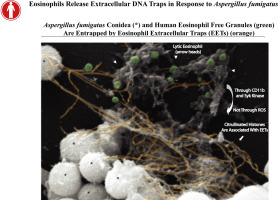Journal of Allergy and Clinical Immunology ( IF 14.2 ) Pub Date : 2017-09-21 , DOI: 10.1016/j.jaci.2017.07.048 Valdirene S. Muniz , Juliana C. Silva , Yasmim A.V. Braga , Rossana C.N. Melo , Shigeharu Ueki , Masahide Takeda , Akira Hebisawa , Koichiro Asano , Rodrigo T. Figueiredo , Josiane S. Neves

|
Background
Eosinophils mediate the immune response in different infectious conditions. The release of extracellular DNA traps (ETs) by leukocytes has been described as an innate immune response mechanism that is relevant in many disorders including fungal diseases. Different stimuli induce the release of human eosinophil ETs (EETs). Aspergillus fumigatus is an opportunistic fungus that may cause eosinophilic allergic bronchopulmonary aspergillosis (ABPA). It has been reported that eosinophils are important to the clearance of A fumigatus in infected mice lungs. However, the immunological mechanisms that underlie the molecular interactions between A fumigatus and eosinophils are poorly understood.
Objective
Here, we investigated the presence of EETs in the bronchial mucus plugs of patients with ABPA. We also determined whether A fumigatus induced the release of human eosinophil EETs in vitro.
Methods
Mucus samples of patients with ABPA were analyzed by light and confocal fluorescence microscopy. The release of EETs by human blood eosinophils was evaluated using different pharmacological tools and neutralizing antibodies by fluorescence microscopy and a fluorimetric method.
Results
We identified abundant nuclear histone-bearing EETs in the bronchial secretions obtained from patients with ABPA. In vitro, we demonstrated that A fumigatus induces the release of EETs through a mechanism independent of reactive oxygen species but associated with eosinophil death, histone citrullination, CD11b, and the Syk tyrosine kinase pathway. EETs lack the killing or fungistatic activities against A fumigatus.
Conclusions
Our findings may contribute to the understanding of how eosinophils recognize and act as immune cells in response to A fumigatus, which may lead to novel insights regarding the treatment of patients with ABPA.
中文翻译:

嗜酸性粒细胞释放烟曲霉毒素后胞外DNA陷阱
背景
嗜酸性粒细胞在不同的感染条件下介导免疫反应。白细胞释放细胞外DNA陷阱(ETs)已被描述为一种固有的免疫反应机制,与包括真菌疾病在内的许多疾病有关。不同的刺激诱导人嗜酸性粒细胞ETs(EETs)的释放。烟曲霉是一种机会性真菌,可能引起嗜酸性变应性支气管肺曲霉病(ABPA)。据报道,嗜酸性粒细胞对感染小鼠肺中烟曲霉的清除很重要。然而,对烟曲霉和嗜酸性粒细胞之间的分子相互作用基础的免疫学机制知之甚少。
客观的
在这里,我们调查了ABPA患者的支气管粘液栓塞中EET的存在。我们还确定了烟熏是否能在体外诱导人嗜酸性粒细胞EET的释放。
方法
通过光和共聚焦荧光显微镜分析ABPA患者的粘液样本。使用不同的药理学工具并通过荧光显微镜和荧光法中和抗体来评估人血嗜酸性粒细胞释放的EET。
结果
我们从ABPA患者的支气管分泌物中发现了丰富的含核组蛋白的EET。在体外,我们表明,烟曲霉菌诱导的EET的释放通过机构独立的活性氧物种的但具有嗜酸性粒细胞死亡,组蛋白瓜氨酸化,CD11b的相关联,并且所述的Syk酪氨酸激酶途径。EET缺乏针对烟曲霉的杀灭或抑真菌活性。
结论
我们的发现可能有助于了解嗜酸性粒细胞如何识别和响应烟气作为免疫细胞,这可能导致有关ABPA患者治疗的新见解。



























 京公网安备 11010802027423号
京公网安备 11010802027423号